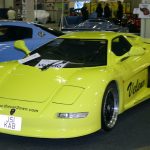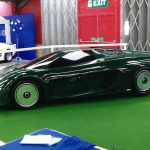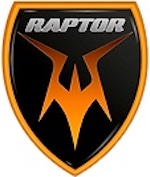THE STORY OF LYNCAR – INCLUDING WILT ‘THE STILT’ CHAMBERLAIN’S ‘SEARCHER 1’ PROJECT
Most specialist car enthusiasts of today won’t have heard of a company called Lyncar, as they appeared on our radar for a very brief period nearly 30 years ago, but as STEVE HOLE reports there was quite a story behind the business.
Lyncar Engineering was based in Slough, Berkshire and run by a very clever engineer called Martin Slater, born in Windsor in 1936. Back in the Sixties, the motorsport enthusiast had built – and raced – his own Formula Junior and F3 cars.
Slater’s first car build, the Cheetah, aka the Martin Slater Special, raced in 1963. It was based on Ford Anglia 105E components.
As far as a day job was concerned, Martin worked as a design engineer for leading motorsport teams including Brabham, Lola, McLaren and March so he is clearly a very talented engineer. I think his Christian name could be Harold but he uses his middle name, Martin.
In the seventies Martin founded Lyncar Engineering, working from premises in Slough and if you are followers of Formula One history the Lyncar name may sound familiar. That’s because they were one of the plethora of garagista privateer teams that occupied the back of F1 grids for many years. Under-financed, living hand-to-mouth, but chock of passion.
In Lyncar’s case, they entered the British GP in 1974 and 1975, with Nicholson-McLaren Engines founder John ‘Nic’ Nicolson doing the driving duties in the Lyncar 006. For the record, he did manage to qualify for the 1975 race. Nicholson qualified 26th running as high as 17th before an accident put paid to his race on lap 51.

Many years later, Keith Kirk, formerly of the Fiero Factory acquired the project and reworked it into the Veleno. Hie dispensed with the sophisticated aluminium monocoque creating a more conventional spaceframe for it instead while basing it on Ford Granada mechanicals including 2.3 or 2.9-litre V6 engine. He also did a second version on MR2 Mk2
The car featured a monocoque crafted by Maurice Gomm in Leatherhead and powered by an old Cosworth DFV entered under the Lyncar-Ford name. It was actually entered under the Pinch (Plant) Ltd banner.
Incidentally, the Lyncar name is actually a conflation of ‘LYN’ and CARol’, Slater’s wife and daughter, respectively.
The company had begun by building cars for the Formula Atlantic series (Lyncar 001) for the 1971 season with Mike Endean initially responsible for the driving duties before Kiwi John Nicholson took over. The latter won the British Formula Atlantic championship in 1971.
Nicholson was the usual works driver and although when he co-founded Nicholson-McLaren Engines in 1972 his outings for the Lyncar team became less frequent he still turned out when he could. He also completed in the lesser, national-level Aurora F1 Series that also saw F5000 cars on the grid. Lyncar built a few of them, too.
In 1976, Spanish rent-a-driver, Emilio de Villota rented a corner of Slater’s workshop and ran a privateer McLaren M23 (this was once James Hunt’s F1 car), a McLaren M25 (F5000) and latterly a Lotus 78.
When Slater fancied an attack on the Shellsport International single-seater series he wanted a very experienced driver, so with de Villota and really an experienced driver he put the also very talented de Villota in the Lyncar 007 in 1977 with Iberia airlines sponsorship and livery on the car.
Another interesting project for Lyncar (in addition to building the odd hillclimb car) was commissioned by Greek driver, Costas Los, to run his Modsport Fiat X1/9. This was the ex-Radbourne Racing-tuned; Dallara built car previously driven by Steve Soper and Steve Small. Los and Slater were friends so it was logical for him to turn to Slater for set-up and prep assistance.
Los was a very interesting character and a decent driver. He came from a Greek shipping family although lived mainly in London where he also owned a restaurant. He later owned Spice Engineering along with Jean-Louis Ricci, for a time.
I think it possible that he ran the X1/9 under his own Cosmik Motorsport with the team run by none other than Keith Greene – talking of interesting characters – with Slater running the car mechanically.
Slater later built a Lyncar for Los to campaign in the World Endurance Championship. It was called the MS83 and was a very pretty thing powered by a Hart 001 2-litre engine. It made its debut at the end of the 1983 season in a low-key club race at Brands Hatch before Los raced it in WEC for the 1984 season.
Initially, it was entered in the IMSA GTP class before once it became apparent that the Cosworth DFL 3.9-litre engine was the engine to have, he switched to C2 turn mid-season. Slater had bought the engine secondhand and it had been built by John Judd.
Los was usually partnered by Les Blackburn or Allen Berg, the highly talented French-Canadian driver. The MS83 was rebodied for 1985, but after a couple of test sessions, Los abandoned the project. Instead, he bought an IMSA-spec March 83G-4 from the American Kneepy Krauly Racing and he had Slater convert that to Group C-spec instead.
Away from running his own cars, Slater and his team, who included Harold Wood, prepared and built cars for other people. The Ceekar 83J-1, built for Ark Racing for Group C2, was one. There were many other projects and odd jobs undertaken by Lyncar. Remember that Martin Slater was a very talented engineer and so was always in demand.
Lyncar also had a very interesting sideline, much like Alan Mann Racing and built cars for the film industry. Slater built loads of different things including the six-wheeled armoured car for the Sci-Fi film ‘Aliens 2 – On Earth’ which picked up on the success of ‘Alien’ the box-office smash of 1979 starring Sigourney Weaver.
Slough wasn’t far from the UK film hubs of Shepperton and Pinewood and had lots of contacts.
Martin came onto the kitcar industry radar following one very special commission from American basketball superstar, Wilt ‘The Stilt’ Chamberlain, who fancied having a racecar for the road in 1986. The design was by Peter Bohanna (previously of kitcar outfit Bohanna Stables, responsible for the Nymph).
Slater received the brief during a meeting with Chamberlain and had the perfect underpinnings for the project in the shape of his Group C car complete with aluminium monocoque.
A hasty re-style was required as Chamberlain was a colossal 7ft1in tall. I believe that he had to literally cut the car in half and add 10in to the wheelbase to accommodate his giant customer in the cockpit, which was itself stretched 6in, while a passenger seat was also added. The car was called the Chamberlain Searcher 1. Unsurprisingly, it wanted for nothing and had an amazing specification including a 460bhp Ford V8 engine.
Slater later decided to offer a version of the car as a kitcar and Lyncar Motor Company exhibited at the National Kitcar Motor Show at Stoneleigh in 1992 where it was very well received. By this time, the car had definite Jaguar XJ220 styling cues although was not a replica.
No orders were forthcoming though and although I think you could technically still buy one for several years, Slater concentrated on his design and engineering consultancy work, while also helping his wife run Lyncar Stables equestrian centre, in Reading.
He always had a regular stream of cars through the garage door as his set-up skills are legendary. Customers included the driver of at least one STM Loco for the 750 Motor Club’s Locost Championship, incidentally.
At some point, the Slater moved to Llandeilo in Carmarthenshire,
Meanwhile, the Lyncar project was sold in the late nineties to Keith Kirk who developed it into the Veleno in 2006. He heavily revised the Lyncar and he dispensed with the aluminium monocoque and created a spaceframe chassis for it which was designed to accept Ford Granada parts and Ford V6 power.
When Keith sadly died suddenly the Auto Speciali projects were marketed by Vindicator Cars for a time, including the other version that Kirk had devised based on Toyota MR2 Mk2.
| Print article | This entry was posted by admin on August 25, 2022 at 6:43 pm, and is filed under Uncategorized. Follow any responses to this post through RSS 2.0. Both comments and pings are currently closed. |
Comments are closed.

















